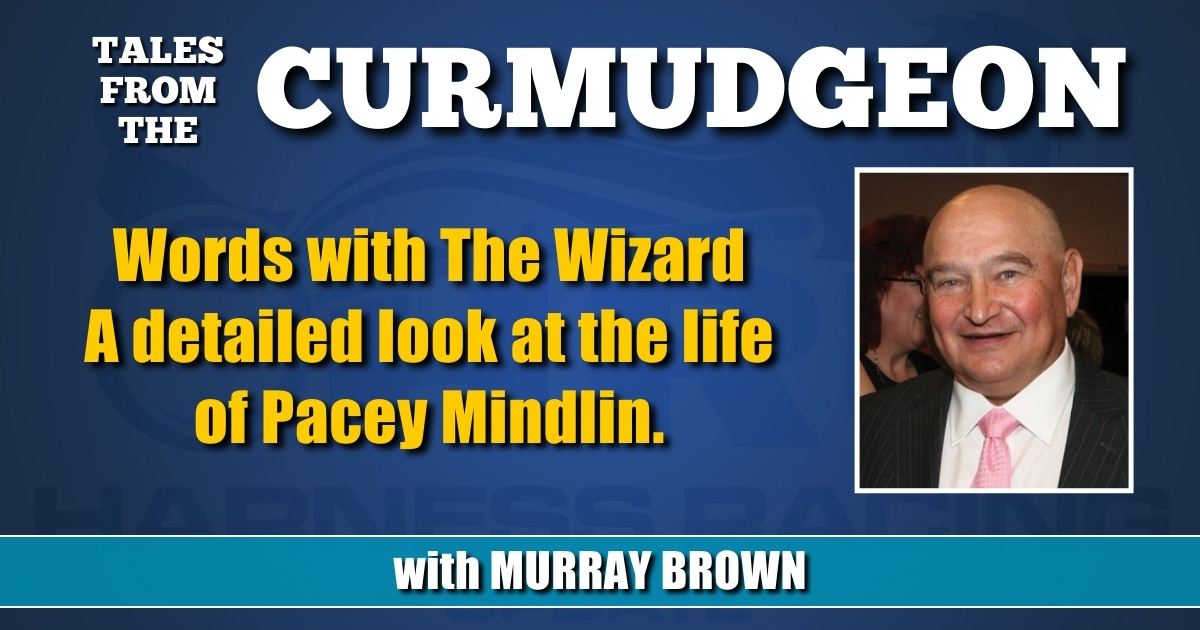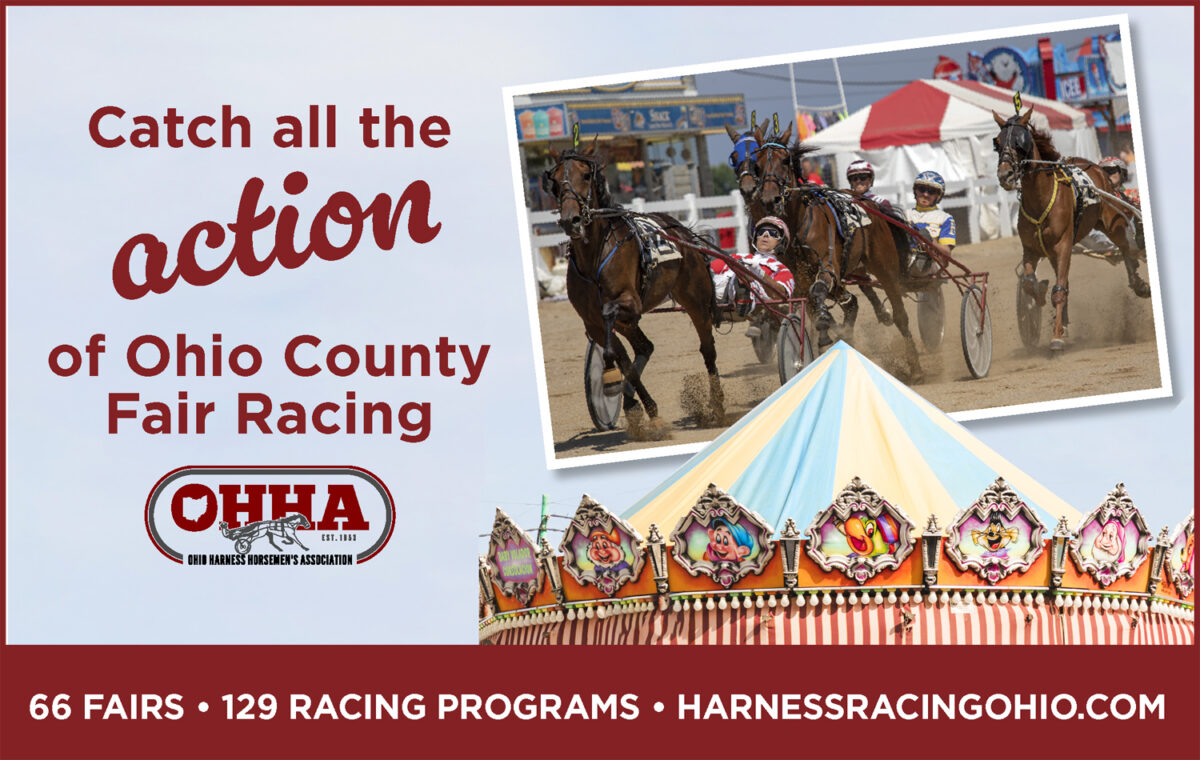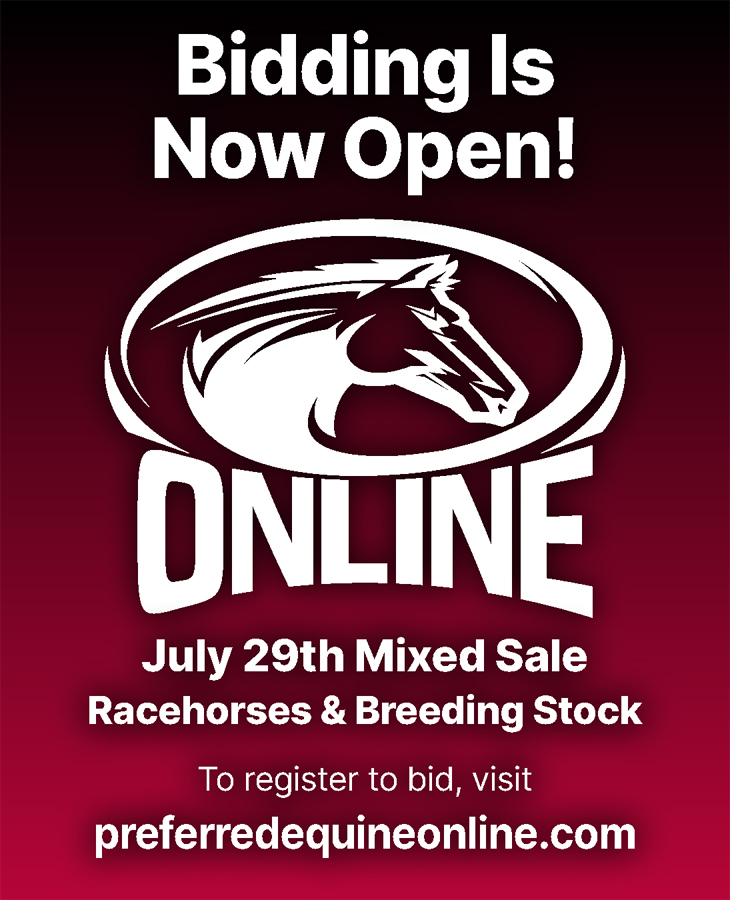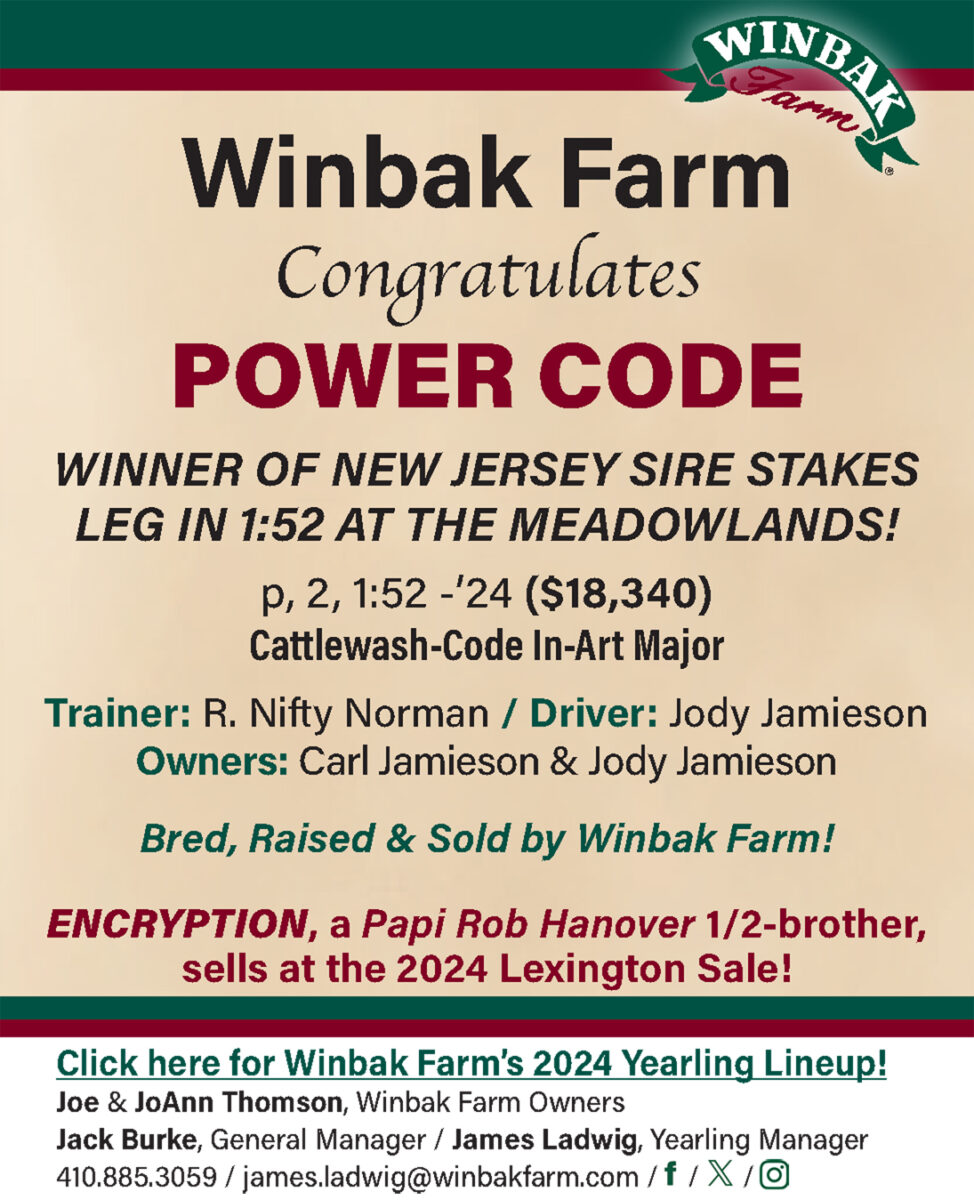

Words with The Wizard
A detailed look at the life of Pacey Mindlin.
by Murray Brown
The Wizard, also known as Pacey Mindlin, is what this author refers to as a “lifer” in this world of harness racing.
He has been a lover of sports — specifically horse racing and more specifically harness racing — for as long as he can remember.
He came by his affinity for sports and gambling through his father, Sandee, who took him to all the sporting events and gambling venues that he frequented.
He recalls being able to read a racing form, before he could read “Run Spot Run” in the first grade.
His first winning wager was on Citation at the age of six or seven — Wizard’s age, not Citation’s.
I have known The Wizard for at least 50 years.
If I were asked to describe him, the first thought to come into my mind would be “a nut,” but a lovable and sometimes a semi-brilliant one.
We are of the same generation and are separated by only two months in age.
Our backgrounds are somewhat similar.
We began in the business in somewhat the same manner — as gamblers.
The major difference between us is that I consider myself to be semi-sane, while Wiz is only slightly removed from the nuthouse. But beneath that clown exterior, lives a real thinker.
Wizard’s background in the sport is varied. He has enjoyed success in several phases of the business. Most, even those who know him, probably do not appreciate the various areas of the sport in which he has enjoyed success.
He began as a gambler and became by his own reckoning “a fairly successful one.” He still maintains a presence in the wagering landscape as the track handicapper at Miami Valley and Yonkers Racetracks and on the Ohio Fair Circuit.
How did this great journey in sports, and specifically in horse racing, begin for you?
“I always loved sports, especially baseball. But there has never been a sport that I didn’t enjoy watching and following. My father first took me to the flats at River Downs here in Ohio. I wasn’t even 10 years old. He would dress me in a summer suit and a clip on tie and we’d go to the races. He’d get me a hamburger in the clubhouse. I’d munch on the burger and watch the races. I loved every minute of it.”
How about harness racing specifically?
“We lived in the small Ohio town of Middletown. The scrap yard was in Franklin, just neighboring. I still live there. It was adjacent to where my father had established his scrapyard that I eventually inherited. I ran it for over half a century before selling it just a few years ago. There were several people in Franklin who owned racehorses which raced at nearby Lebanon Raceway. I became interested and started going. This area is a Mecca for sports. Cincinnati is close by. I’ve been a Reds and Bengals fan all of my life. Middletown is where one of the greatest basketball players ever, Jerry Lucas, was from and where he played in high school. His coach Paul Walker was a great harness racing fan and I knew him well.
“I saw Chuck Noll play linebacker at the University of Dayton.
“I was a huge fan of fair racing in Ohio. The first and greatest attended fair I ever went to was at Greenville. They were racing the H M Parshall Futurity. B F Coaltown was racing against Interloper. B F Coaltown won. It was wall to wall people in extreme heat. But everybody had a great time.”
How did you get involved in the sport?
“I think it was 1964. Corwin Nixon who was the face of Lebanon and the Hamilton Racetrack called and offered me a job as a patrol judge at Hamilton I remember going there, but couldn’t get on the stand that had been erected because a nest of wasps had taken up residence in it. Awhile later, Lyle Stuart who was a judge at Lebanon, called and told me to put on a suit and tie and come to the judge’s stand. One of the associate judges could not be there and he wanted me to substitute. I remember him praising me after the race for getting all the finishing positions right. I told him, ‘I went to college. I can count to eight.’ I remember Lyle being so proud of having seen both Greyhound and Billy Direct race on the same card. Lyle also had his own small farm where he raised a few horses. He ended up selling that farm to a fella by the name of Neil Armstrong. Yes, that Neil Armstrong.”
Most of your formative years were spent at or around Lebanon Raceway. What was that like?
“It was great! Most people think that Lebanon was owned by Corwin Nixon. It wasn’t. It was owned by the county. He and the Carlo family each owned a meet that raced there. He was the face of and had a hand in running it. Lou Carlo, on behalf of the Carlo family ran the other meet. I believe that Lou was as great at running a racetrack as anybody that ever lived. He knew racing and he loved it. He was a visionary, at least in Ohio he was. I’m bragging, as I sometimes have been accused of doing. I believe that Lou, Mel Hagemeyer and myself played a big part in beginning racing for Ohio-breds in our state. It was due to our urging that races for Ohio-bred horses began at Lebanon, the first track in the state to card them.
“It was at the initiative of Lou Carlo that we did the first broadcast of the Kentucky Futurity from the Red Mile. At first I didn’t want to go. It came up in conflict with the eve of the Jewish High Holidays. The race would be over early enough for me to get home in time to go to temple. I didn’t count on getting lost, which I did. I ended up missing the services completely. My mother never forgave me. Lou Carlo was also the man who named me Wizard.”
Lebanon was known as a great beginner’s track for great drivers. Among the most famous alumni were David Miller, Mike Wilder and Eric Ledford.
“I like to joke with people by telling them that they would never have heard of any of those guys if not for me. They all were very talented and made a mark from the beginning. I think I might have been instrumental in getting David his first drive of consequence. Mickey McNichol had been driving Merrilywerollalong and got in an accident. I was speaking to his owner Jeff Langfelter when David walked by. I said to Jeff, ‘There’s your driver. That kid can drive with anybody.’ David drove and won the race.
“I used to buy Mike Wilder his pizza. (*Author’s note: The Wizard has never been known for buying anything for anybody. He is almost always the buyee, rather than the buyer) One day Mike booked off one of my horses. That was when I stopped buying him pizza.
“Eric Ledford has to be one of harness racing’s greatest tragedies. He was as talented a driver as ever lived. I remember Gene Riegle saying something to the effect that he’d never seen anybody who could drive a horse better. I don’t know what happened. Perhaps success came too fast and too early.”
You’ve done a lot in the sport that many do not realize you have. For example, you were a judge for 20 years.
“Most of my judging took place on the Ohio Fair Circuit and at Lebanon Raceway. I was also an associate judge at Latonia (now Turfway Park) Raceway for a few meets. I was judging there when Abercrombie broke his maiden.”
Tell us about some of the good horses you’ve owned.
“I first got interested in bloodlines through a fellow by the name of Bill Hufford who was a student of pedigrees. He stood a horse by the name of Adio Abe who I believe was the first son of Adios to enter the stud. I think that Adio Abe ended up standing stud in your part of the world — in Quebec. Bill would talk bloodlines with me for hours on end. I began following them as well. He was a good friend of Bill Brown who was then the farm manager at Castleton. He introduced me to Bill Brown and we became friends. Whenever I was shopping for yearlings I would speak with Bill and Carter Duer.
“The first horse I owned was named Leo The Byrd. I bought him for $750. He had a bowed tendon. I had no idea what a bowed tendon was and how badly that could compromise a racehorse. Needless to say he didn’t stay sound. I owned him in partnership with Dave McLonahy, who sadly was one of the first Americans killed in Vietnam.
“Another horse I owned early on was a Worthy Boy pacer by the name of Plucky Boy. I owned him with a fellow by the name of Jackie Johns who worked at Fair Chance Farm where Adios Butler stood.
“A fellow by the name of Ron Stokely worked at Arnco Steel in Franklin. He had been a quarterback at the University of Florida. He also trained a horse or two on the side. I grew up with the Zollet twins. We were going to buy a yearling together and Ron would train it. We went to Lexington to find one. Of course the person I sought out for advice was Bill Brown.
“We were focused on a horse by the name of Hammering Hank, but we were outbid.
“We ended up by buying Lightning Wave For $12,000. Ron trained him in Franklin. He was by Shadow Wave and his dam was a full sister to Best of All and Coffee Break. As a 2-yer-old, he won the Standardbred Stakes at Delaware Ohio. At 3, he won a heat of the Little Brown Jug. At 4, he won the American National at Sportsman’s Park. We three kids from Ohio were walking in high cotton!
“Through the years, I’ve been fortunate enough to have owned a decent number of good horses. I never owned many horses at a time. Among them were Goodbye Columbus, Norma Ruth Hanover, Pointer Hanover and Joyful Crown who was the grandam of the great Mr Muscleman. I’ve also won three sires stakes finals in Ohio and two in Indiana.
“The one that got away was Fan Hanover. I bid on her but stopped. I was never one to spend too much on yearlings.
“I’ve been extremely fortunate. I once had Joe O’Brien and Howard Beissinger drive for me on the same day at Indianapolis.
“Racing has changed, I was going to use the word progressed through the years, but changed my mind.
“I was going to say that Gene Riegle was the greatest horseman I’ve ever seen. Make no mistake about it, he still might be. But the two greatest trainers I believe I’ve ever known have been Brett Pelling and Nifty Norman. I’m sure I’ll get negative feedback on that, but I’m a big boy and can take it.
“I’ve also had several great partners including Mike Kimelman and Kenny Cohen.
“I became great friends with Mike. I might have known well before the industry that Bill Brown was leaving Castleton and going to Blue Chip Farms. Kimelman wanted the man he believed to be the best farm manager around to run his new showplace farm. After Bill moved there I’d often visit and spend weekends at the farm staying there.
“Mike became my financial advisor. His firm still handles my investments.
“I had two of the greatest trainers that ever lived in Herb Coven and Jim Dailey. Sadly, both died young. Both Herb and Jim were content in Ohio and wouldn’t leave the state often. I believe that if they ever had spread their wings, they would have been able to compete with anyone, anywhere.”
For the majority of your life you embraced bachelorhood. You didn’t get married until you turned 49.
“I suppose I was just waiting to meet the right one. It surely was worth the wait. My Debbie is just fantastic. She is the sweetest, best and most supportive woman I’ve ever known. Perhaps more importantly, she puts up with me.”
You owned a scrap business for 55 years and then sold out. Do you miss it?
“Maybe a little, but just a little. I miss the people more than the business. I was privileged to have known and been a friend of the former Speaker of the House John Boehner and Mark Kennard, my banker and the father of Duke and now NBA star, Luke Kennard. I saw Luke grow up and become the wonderful young man he is now. I bred a yearling colt that I own that I named Buzzer Beater. I named him after Luke.”
So, you are now 80. How is life treating you?
“Pretty darn good. I’m old, but I don’t feel it. I have the best wife and friend in the world in Debbie. I still follow all sports, especially racing and the breeding of horses. I do the handicapping for Miami Valley, Yonkers and the Ohio Fairs. At the fairs, they call my picks Wizard’s Winning Numbers. I hope we soon get over this COVID nonsense. I would love to take a road trip with Luke Kennard and the Clippers, hopefully this coming season.”
Have a question or comment for The Curmudgeon?
Reach him by email at: hofmurray@aol.com.















